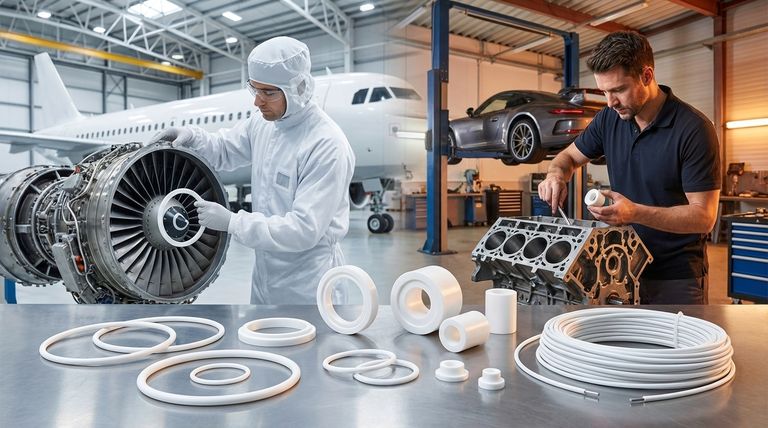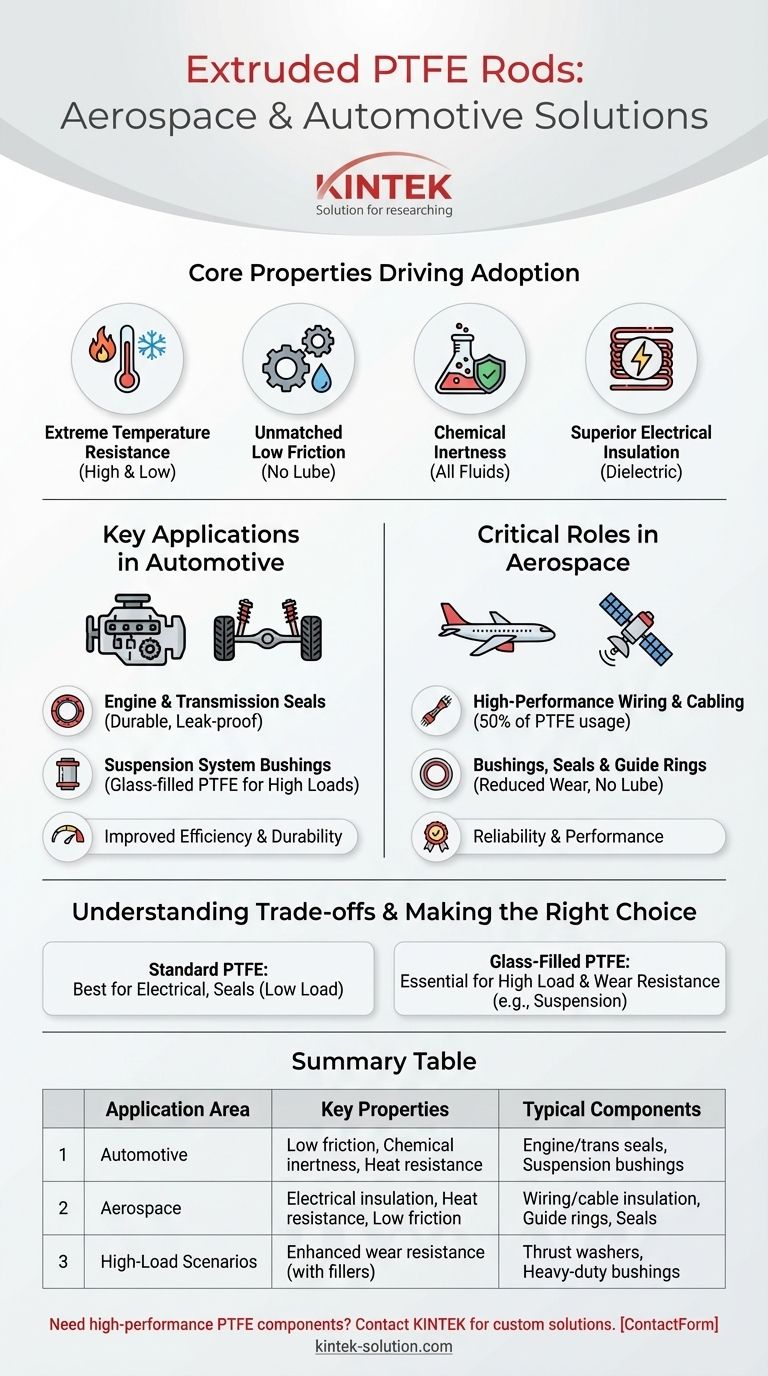In the aerospace and automotive industries, extruded Polytetrafluoroethylene (PTFE) rods are machined into critical components like high-temperature seals, low-friction bushings, and high-performance electrical wiring insulation. These applications leverage PTFE's unique ability to function reliably under extreme conditions where conventional materials would fail, directly improving vehicle efficiency, safety, and longevity.
The core reason PTFE is indispensable in these sectors is its rare combination of properties: extreme heat resistance, near-total chemical inertness, an exceptionally low coefficient of friction, and superior electrical insulation. No single material delivers this level of performance across such a wide operational range.

Core Properties Driving Adoption
To understand PTFE's role, we must first examine the fundamental material characteristics that make it so valuable for high-stakes engineering.
Extreme Temperature Resistance
PTFE maintains its integrity across a vast temperature spectrum. This makes it ideal for components near engines, exhaust systems, and other high-heat environments in both cars and aircraft.
Unmatched Low Friction
Extruded PTFE has a coefficient of friction often compared to wet ice on wet ice. This property allows parts like bushings and guide rings to operate smoothly without external lubrication, significantly reducing mechanical wear.
Chemical Inertness
PTFE is resistant to virtually all common industrial chemicals, fuels, and corrosive fluids. This allows it to be used for seals and gaskets in engine and hydraulic systems without risk of degradation.
Superior Electrical Insulation
With excellent dielectric properties and a high melting temperature, PTFE is a premier material for insulating wires and cables. It provides a high-performance substitute for materials like polyethylene, especially in critical aerospace systems.
Key Applications in Automotive
In the automotive sector, PTFE components directly contribute to improved fuel efficiency and vehicle durability by reducing friction and preventing leaks.
Engine and Transmission Seals
PTFE rods are machined into durable seals for engine components and transmissions. Their ability to withstand high temperatures and aggressive fluids ensures a long, reliable service life, preventing costly leaks.
Suspension System Bushings
For high-load applications, glass-filled PTFE is often used. The addition of glass fibers enhances mechanical strength and wear resistance, making it perfect for suspension bushings and thrust washers that must endure heavy, dynamic loads.
Critical Roles in Aerospace
In aerospace, where reliability and performance are non-negotiable, PTFE is used for a range of components from mechanical assemblies to essential wiring.
High-Performance Wiring and Cabling
Nearly 50% of all PTFE produced is used for wiring insulation in aerospace and computer applications. Its heat resistance and dielectric strength are critical for hook-up wires and coaxial cables that must perform flawlessly.
Bushings, Seals, and Guide Rings
In moving assemblies within aircraft, PTFE components reduce the need for lubrication, which can be difficult to apply and maintain in aerospace environments. This reduces wear and extends the life of critical systems.
Understanding the Trade-offs
While PTFE's properties are exceptional, selecting the correct grade is crucial for successful implementation. The material's primary limitation is its mechanical strength.
Standard vs. Filled PTFE
Standard, unfilled PTFE is relatively soft and can be susceptible to "creep" or cold flow under sustained pressure. While perfect for many seals and electrical applications, it is not ideal for high-load structural components.
The Need for Reinforcement
To overcome this, fillers like glass fiber are added to the PTFE during manufacturing. This creates a composite material with significantly improved wear resistance and load-bearing capacity, making it suitable for demanding applications like automotive suspension parts.
Making the Right Choice for Your Goal
Selecting the right type of PTFE rod depends entirely on the specific demands of your application.
- If your primary focus is electrical insulation and thermal stability: Standard extruded PTFE is the ideal choice for wiring, cables, and non-structural insulators.
- If your primary focus is reducing friction in low-load environments: Standard PTFE provides unmatched performance for seals, guide rings, and lightweight bushings.
- If your primary focus is durability under heavy mechanical loads: A glass-filled PTFE rod is necessary to provide the required strength and wear resistance for components like suspension bushings.
Ultimately, understanding these material properties empowers you to select the precise solution for creating more efficient and resilient systems.
Summary Table:
| Application Area | Key PTFE Properties Utilized | Typical Components |
|---|---|---|
| Automotive | Low friction, Chemical inertness, Heat resistance | Engine/transmission seals, Suspension bushings |
| Aerospace | Electrical insulation, Heat resistance, Low friction | Wiring/cable insulation, Guide rings, Seals |
| High-Load Scenarios | Enhanced wear resistance (with fillers like glass) | Thrust washers, Heavy-duty bushings |
Need high-performance PTFE components for your critical applications?
At KINTEK, we specialize in manufacturing precision PTFE components—from seals and liners to custom labware—for the semiconductor, medical, laboratory, and industrial sectors. Our expertise in custom fabrication, from prototypes to high-volume orders, ensures you get the exact solution to enhance your vehicle or aircraft's efficiency, safety, and longevity.
Let's discuss your project requirements. Contact our team today for a quote!
Visual Guide

Related Products
- Custom PTFE Parts Manufacturer for Teflon Parts and PTFE Tweezers
- Custom PTFE Parts Manufacturer for Teflon Containers and Components
- Customizable PTFE Rods for Advanced Industrial Applications
- Custom PTFE Sleeves and Hollow Rods for Advanced Applications
- Custom PTFE Measuring Cylinders for Advanced Scientific and Industrial Applications
People Also Ask
- What finishing techniques are effective for machined Teflon parts? Achieve Functional Performance and Dimensional Stability
- What chemical processing applications involve PTFE-machined parts? Essential Components for Corrosive & High-Purity Systems
- What are the main applications of PTFE type Teflon? Unlock Its Versatility for Your Industry
- What factors should be considered when choosing between Nylon and PTFE? Select the Right Material for Your Application
- What fabrication services are available for PTFE? Shearing, Stamping, Laser Cutting, Molding & Machining



















